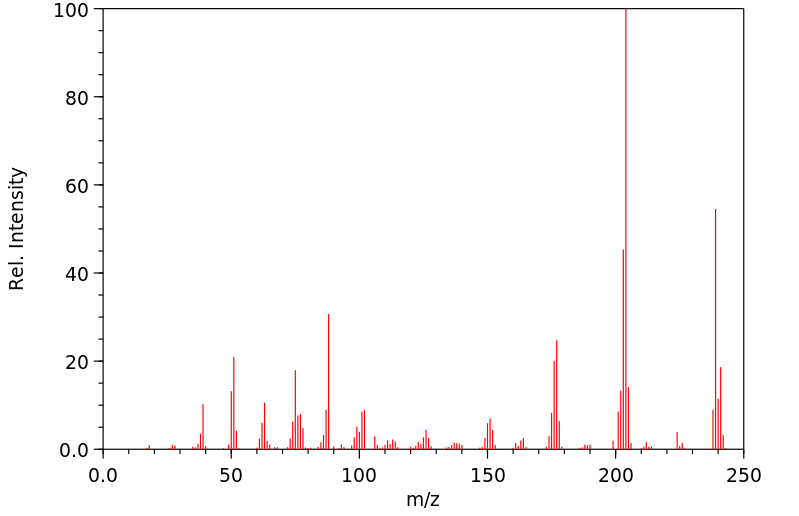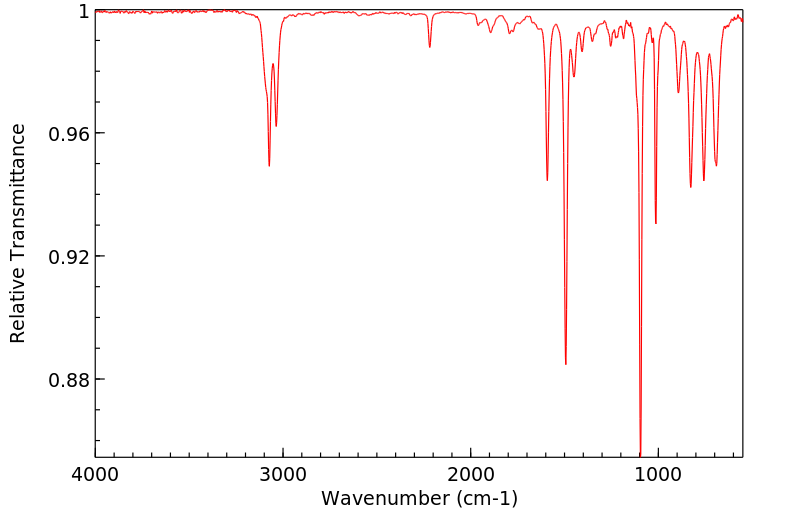(Z)-3-(4-chlorophenyl)-2-phenylacrylonitrile | 37629-64-4
中文名称
——
中文别名
——
英文名称
(Z)-3-(4-chlorophenyl)-2-phenylacrylonitrile
英文别名
3-(p-Chlorophenyl)-2-phenylacrylonitrile;(Z)-3-(4-chlorophenyl)-2-phenylprop-2-enenitrile
CAS
37629-64-4;3695-92-9
化学式
C15H10ClN
mdl
——
分子量
239.704
InChiKey
WHZUHCZQGFNGNH-GXDHUFHOSA-N
BEILSTEIN
——
EINECS
——
-
物化性质
-
计算性质
-
ADMET
-
安全信息
-
SDS
-
制备方法与用途
-
上下游信息
-
文献信息
-
表征谱图
-
同类化合物
-
相关功能分类
-
相关结构分类
物化性质
-
熔点:97-99 °C(Solv: ethanol (64-17-5))
-
沸点:369.0±30.0 °C(Predicted)
-
密度:1.211±0.06 g/cm3(Predicted)
计算性质
-
辛醇/水分配系数(LogP):4.3
-
重原子数:17
-
可旋转键数:2
-
环数:2.0
-
sp3杂化的碳原子比例:0.0
-
拓扑面积:23.8
-
氢给体数:0
-
氢受体数:1
上下游信息
-
下游产品
中文名称 英文名称 CAS号 化学式 分子量 —— α-Phenyl-p-chlorzimtaldehyd 67945-93-1 C15H11ClO 242.705
反应信息
-
作为反应物:描述:(Z)-3-(4-chlorophenyl)-2-phenylacrylonitrile 在 二异丁基氢化铝 作用下, 以 甲苯 为溶剂, 反应 1.0h, 生成 3-(4-chlorophenyl)-2-phenylacrylaldehyde参考文献:名称:[EN] INHIBITORS OF THE N-TERMINAL DOMAIN OF THE ANDROGEN RECEPTOR
[FR] INHIBITEURS DU DOMAINE N-TERMINAL DU RÉCEPTEUR ANDROGÈNE摘要:本公开提供了抑制或降解雄激素受体N-末端结构域的化合物和方法,以及治疗前列腺癌等癌症的方法。公开号:WO2020205470A1 -
作为产物:参考文献:名称:锰催化伯醇对腈的α-烯烃化摘要:介绍了通过醇与腈的脱氢偶联,使用伯醇催化 α-烯化腈。该反应由富含地球的金属(锰)的钳状络合物催化,不存在任何添加剂、碱或氢受体,释放出氢和水作为唯一的副产物。DOI:10.1021/jacs.7b06993
文献信息
-
Environmentally Friendly One-Pot Synthesis of α-Alkylated Nitriles Using Hydrotalcite-Supported Metal Species as Multifunctional Solid Catalysts作者:Ken Motokura、Noriaki Fujita、Kohsuke Mori、Tomoo Mizugaki、Kohki Ebitani、Koichiro Jitsukawa、Kiyotomi KanedaDOI:10.1002/chem.200600317日期:2006.11.6diameter of about 70 A is observed on the Pd(nano)/HT surface by transmission electron microscopy analysis. These hydrotalcite-supported metal catalysts can effectively promote alpha-alkylation reactions of various nitriles with primary alcohols or carbonyl compounds through tandem reactions consisting of metal-catalyzed oxidation and reduction, and an aldol reaction promoted by the base sites of the通过处理碱性层状双氢氧化物,水滑石(HT,Mg(6)Al(2)(OH)( 16)CO(3))与RuCl(3)n H(2)O和K(2)[PdCl(4)]水溶液分别使用表面浸渍法。通过X射线衍射,能量色散X射线,电子顺磁共振和X射线吸收精细结构光谱分析,证明了Ru(IV)单体已接枝到HT的表面。同时,在减少表面分离的Pd(II)种类之后,通过透射电子显微镜分析在Pd(纳米)/ HT表面上观察到平均直径为约70A的高度分散的Pd纳米团簇。这些水滑石负载的金属催化剂可通过由金属催化的氧化和还原组成的串联反应,以及由HT的碱位促进的羟醛反应,有效地促进各种腈与伯醇或羰基化合物的α-烷基化反应。在这些催化的α-烷基化反应中,均质的碱是不必要的,唯一的副产物是水。另外,这些催化剂体系适用于戊二腈衍生物的一锅法合成。
-
Atmosphere-Controlled Chemoselectivity: Rhodium-Catalyzed Alkylation and Olefination of Alkylnitriles with Alcohols作者:Junjun Li、Yuxuan Liu、Weijun Tang、Dong Xue、Chaoqun Li、Jianliang Xiao、Chao WangDOI:10.1002/chem.201704037日期:2017.10.17The chemoselective alkylation and olefination of alkylnitriles with alcohols have been developed by simply controlling the reaction atmosphere. A binuclear rhodium complex catalyzes the alkylation reaction under argon through a hydrogen‐borrowing pathway and the olefination reaction under oxygen through aerobic dehydrogenation. Broad substrate scope is demonstrated, permitting the synthesis of some
-
Synthesis, Characterisation and Photophysical Properties of α,β-diaryl-acrylonitrile Derivatives作者:Youfeng Yue、Haiyan Fang、Meijun Wang、Zhiyuan Wang、Mingxin YuDOI:10.3184/030823409x460687日期:2009.6α,β-Diarylacrylonitrile derivatives can be prepared by two different routes: (1) the intermolecular condensation of the same arylacetonitriles (2) the condensation of arylaldehydes and arylacetonitriles with a catalytic amount of NaOCH3 at room temperature. Several α,β-diarylacrylonitrile derivatives have been synthesised in this paper and characterised. The UV-vis absorption and photoluminescent (PL)
-
Organic Photochemical Rearrangements of Triplets and Zwitterions; Mechanistic and Exploratory Organic Photochemistry作者:Howard E. Zimmerman、Vijay SuryanarayanDOI:10.1002/ejoc.200700456日期:2007.8subsequently as S0 ground state zwitterions or diradicals. We now have some new rearrangements bearing on these questions. In some cases it is the triplet which rearranges, while in others it is the S0 zwitterion. The zwitterion vs. diradical nature of the S0 species has been assessed by both experimental as well as theoretical means. Similarly, both experiment and computational theory have been used关于烯酮和二烯酮的反应机制一直存在争议。问题是是否涉及两性离子或双自由基作为中间体。在基态物种的情况下,尚未认识到两性离子可能具有双自由基特性。在三线态反应中,存在重排是在初始 T1 阶段发生还是随后作为 S0 基态两性离子或双自由基发生的问题。我们现在对这些问题有了一些新的重新安排。在某些情况下,重新排列的是三重态,而在其他情况下,则是 S0 两性离子。S0 物种的两性离子与双自由基性质已通过实验和理论手段进行了评估。相似地,实验和计算理论已被用于确定三重重排发生在哪个阶段,并确定重排物种的特征。(© Wiley-VCH Verlag GmbH & Co. KGaA, 69451 Weinheim, Germany, 2007)
-
Stabilization of Organic Materials申请人:Gerster Michele公开号:US20080269382A1公开(公告)日:2008-10-30The invention describes a process for stabilizing an organic material against oxidative, thermal or light-induced degradation, which comprises incorporating therein or applying thereto at least a compound of the formula (I) wherein the general symbols are as defined in claim 1 . The compounds of the formula I are especially useful as processing stabilizers for synthetic polymers.该发明描述了一种用于稳定有机材料抵抗氧化、热降解或光诱导降解的过程,其中包括将化合物(I)至少混入其中或应用于其中,其中通式中的一般符号如权利要求1所定义。通式I的化合物特别适用作合成聚合物的加工稳定剂。
表征谱图
-
氢谱1HNMR
-
质谱MS
-
碳谱13CNMR
-
红外IR
-
拉曼Raman
-
峰位数据
-
峰位匹配
-
表征信息
同类化合物
(E,Z)-他莫昔芬N-β-D-葡糖醛酸
(E/Z)-他莫昔芬-d5
(4S,5R)-4,5-二苯基-1,2,3-恶噻唑烷-2,2-二氧化物-3-羧酸叔丁酯
(4S,4''S,5R,5''R)-2,2''-(1-甲基亚乙基)双[4,5-二氢-4,5-二苯基恶唑]
(4R,5S)-4,5-二苯基-1,2,3-恶噻唑烷-2,2-二氧化物-3-羧酸叔丁酯
(4R,4''R,5S,5''S)-2,2''-(1-甲基亚乙基)双[4,5-二氢-4,5-二苯基恶唑]
(1R,2R)-2-(二苯基膦基)-1,2-二苯基乙胺
鼓槌石斛素
黄子囊素
高黄绿酸
顺式白藜芦醇三甲醚
顺式白藜芦醇
顺式己烯雌酚
顺式-白藜芦醇3-O-beta-D-葡糖苷酸
顺式-桑皮苷A
顺式-曲札芪苷
顺式-二苯乙烯
顺式-beta-羟基他莫昔芬
顺式-a-羟基他莫昔芬
顺式-3,4',5-三甲氧基-3'-羟基二苯乙烯
顺式-1-(3-甲基-2-萘基)-2-(2-萘基)乙烯
顺式-1,2-双(三甲基硅氧基)-1,2-双(4-溴苯基)环丙烷
顺式-1,2-二苯基环丁烷
顺-均二苯乙烯硼酸二乙醇胺酯
顺-4-硝基二苯乙烯
顺-1-异丙基-2,3-二苯基氮丙啶
非洲李(PRUNUSAFRICANA)树皮提取物
阿非昔芬
阿里可拉唑
阿那曲唑二聚体
阿托伐他汀环氧四氢呋喃
阿托伐他汀环氧乙烷杂质
阿托伐他汀环(氟苯基)钠盐杂质
阿托伐他汀环(氟苯基)烯丙基酯
阿托伐他汀杂质D
阿托伐他汀杂质94
阿托伐他汀杂质7
阿托伐他汀杂质5
阿托伐他汀内酰胺钠盐杂质
阿托伐他汀中间体M4
阿奈库碘铵
锌(II)(苯甲醛)(四苯基卟啉)
银松素
铜酸盐(5-),[m-[2-[2-[1-[4-[2-[4-[[4-[[4-[2-[4-[4-[2-[2-(羧基-kO)苯基]二氮烯基-kN1]-4,5-二氢-3-甲基-5-(羰基-kO)-1H-吡唑-1-基]-2-硫代苯基]乙烯基]-3-硫代苯基]氨基]-6-(苯基氨基)-1,3,5-三嗪-2-基]氨基]-2-硫代苯基]乙烯基]-3-硫代
铒(III) 离子载体 I
铀,二(二苯基甲酮)四碘-
钾钠2,2'-[(E)-1,2-乙烯二基]二[5-({4-苯胺基-6-[(2-羟基乙基)氨基]-1,3,5-三嗪-2-基}氨基)苯磺酸酯](1:1:1)
钠{4-[氧代(苯基)乙酰基]苯基}甲烷磺酸酯
钠;[2-甲氧基-5-[2-(3,4,5-三甲氧基苯基)乙基]苯基]硫酸盐
钠4-氨基二苯乙烯-2-磺酸酯








